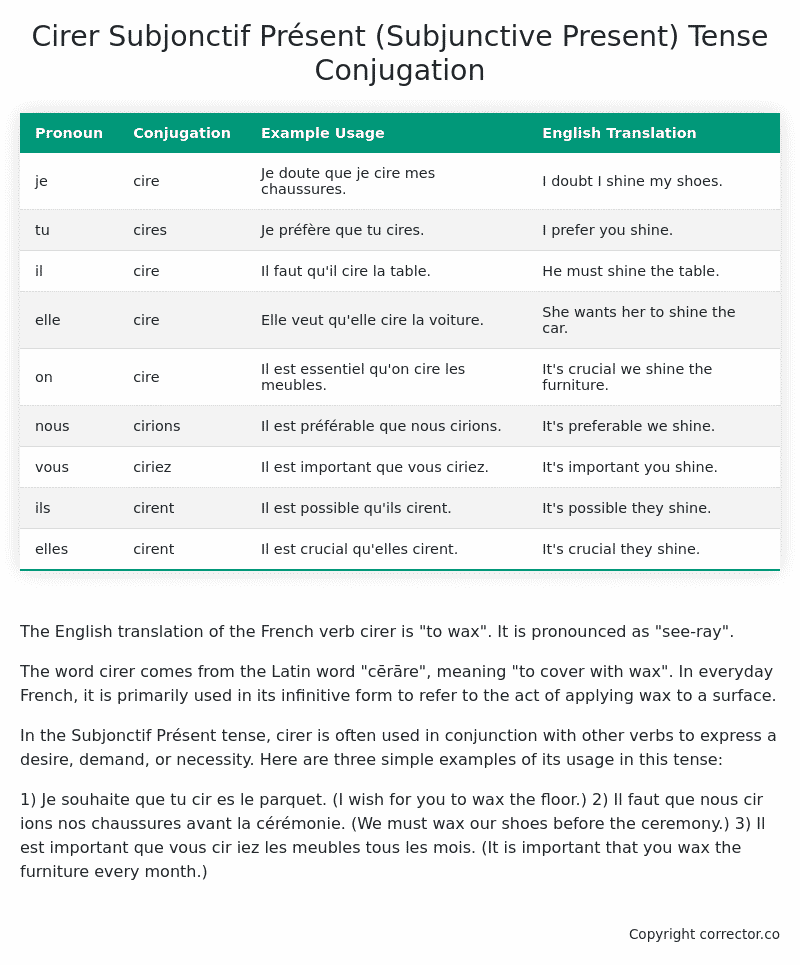Subjonctif Présent (Subjunctive Present) Tense Conjugation of the French Verb cirer
Introduction to the verb cirer
The English translation of the French verb cirer is “to wax”. It is pronounced as “see-ray”.
The word cirer comes from the Latin word “cērāre”, meaning “to cover with wax”. In everyday French, it is primarily used in its infinitive form to refer to the act of applying wax to a surface.
In the Subjonctif Présent tense, cirer is often used in conjunction with other verbs to express a desire, demand, or necessity. Here are three simple examples of its usage in this tense:
1) Je souhaite que tu cir es le parquet. (I wish for you to wax the floor.)
2) Il faut que nous cir ions nos chaussures avant la cérémonie. (We must wax our shoes before the ceremony.)
3) Il est important que vous cir iez les meubles tous les mois. (It is important that you wax the furniture every month.)
Table of the Subjonctif Présent (Subjunctive Present) Tense Conjugation of cirer
| Pronoun | Conjugation | Example Usage | English Translation |
|---|---|---|---|
| je | cire | Je doute que je cire mes chaussures. | I doubt I shine my shoes. |
| tu | cires | Je préfère que tu cires. | I prefer you shine. |
| il | cire | Il faut qu’il cire la table. | He must shine the table. |
| elle | cire | Elle veut qu’elle cire la voiture. | She wants her to shine the car. |
| on | cire | Il est essentiel qu’on cire les meubles. | It’s crucial we shine the furniture. |
| nous | cirions | Il est préférable que nous cirions. | It’s preferable we shine. |
| vous | ciriez | Il est important que vous ciriez. | It’s important you shine. |
| ils | cirent | Il est possible qu’ils cirent. | It’s possible they shine. |
| elles | cirent | Il est crucial qu’elles cirent. | It’s crucial they shine. |
Other Conjugations for Cirer.
Le Present (Present Tense) Conjugation of the French Verb cirer
Imparfait (Imperfect) Tense Conjugation of the French Verb cirer
Passé Simple (Simple Past) Tense Conjugation of the French Verb cirer
Passé Composé (Present Perfect) Tense Conjugation of the French Verb cirer
Futur Simple (Simple Future) Tense Conjugation of the French Verb cirer
Futur Proche (Near Future) Tense Conjugation of the French Verb cirer
Plus-que-parfait (Pluperfect) Tense Conjugation of the French Verb cirer
Passé Antérieur (Past Anterior) Tense Conjugation of the French Verb cirer
Futur Antérieur (Future Anterior) Tense Conjugation of the French Verb cirer
Subjonctif Présent (Subjunctive Present) Tense Conjugation of the French Verb cirer (this article)
Subjonctif Passé (Subjunctive Past) Tense Conjugation of the French Verb cirer
Subjonctif Imparfait (Subjunctive Imperfect) Tense Conjugation of the French Verb cirer
Subjonctif Plus-que-parfait (Subjunctive Pluperfect) Tense Conjugation of the French Verb cirer
Conditionnel Présent (Conditional Present) Tense Conjugation of the French Verb cirer
Conditionnel Passé (Conditional Past) Tense Conjugation of the French Verb cirer
L’impératif Présent (Imperative Present) Tense Conjugation of the French Verb cirer
L’infinitif Présent (Infinitive Present) Tense Conjugation of the French Verb cirer
Struggling with French verbs or the language in general? Why not use our free French Grammar Checker – no registration required!
Get a FREE Download Study Sheet of this Conjugation 🔥
Simply right click the image below, click “save image” and get your free reference for the cirer Subjonctif Présent tense conjugation!

Cirer – About the French Subjonctif Présent (Subjunctive Present) Tense
Formation of the Subjonctif Présent
Common Everyday Usage Patterns
Interactions with Other Tenses
Summary
I hope you enjoyed this article on the verb cirer. Still in a learning mood? Check out another TOTALLY random French verb conjugation!


